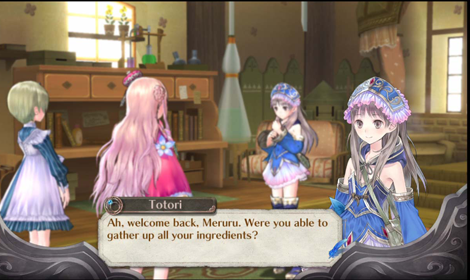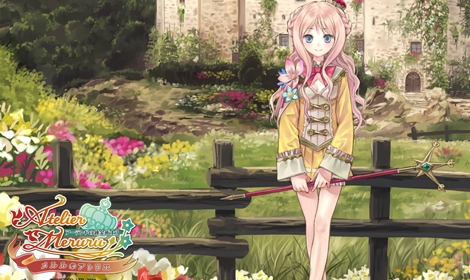As someone who started the Atelier series when I first played Mana Khemia: Alchemists of Al-Revis on the PlayStation 2, the ninth title of Gust's flagship series, I’ve since been enamored with the franchise. Although the series has always been known for its alchemy system, the character development in the game has always been top-notch and included deep, rich backgrounds and succulent designs. Atelier Meruru: the Apprentice of Arland is a wonderful representation of this. It’s a throwback to the time when a game didn’t have notable "different" endings that were actually the same, wasn’t bogged down by battle after battle involving superfluous moral messages, and companies weren’t trying to one up competitors with awe-inspiring shiny high-def graphics. In other words, Atelier Meruru is a JRPG enthusiast's delight.
Taking place several years after the last entry into the series, Atelier Totori: the Adventurer of Arland, Atelier Meruru revolves around the titular character Meruru who is the princess of the rural kingdom of Arls. Faced with the prospect of seeing her kingdom merge with Arland, the setting for Atelier Rorona: the Alchemist of Arland, Meruru is tasked with helping her country prosper via the use of alchemy. While the story isn't as personal as the nakige-style story of Totori, it's much more epic in scope. Veteran players will enjoy seeing some of their favorite characters such as Mimi, Totori, and Sterk return in the highly anticipated sequel as all of their storylines reach a denouement in the trilogy’s final chapter. And although the game's two new characters, Keina and Lias, may seem a tad bit on the drab side when compared to returning favorites, they still have their occasional moments and quirks that may appeal to some gamers.
Unlike Atelier Totori and Rorona where quests and orders are seemingly fulfilled only to advance through ranks and deadlines on a much smaller, more intimate level, everything in Atelier Meruru is done in order to advance the kingdom, and this is where the game truly shines. Similar to other classic titles in the RPG genre such as Dark Cloud and Fable, the game uses a world building mechanic where players get to see the world change dramatically around them in realtime. What may once start off as nothing more than a forest with a single prospector scoping out the land can turn into a bustling military outpost by delivering items or hunting down a local monster. Nothing feels arbitrary, and in the days where seemingly every JRPG is using some sort of item synthesis, this makes Meruru feel fresh, original and innovative. Not to mention that it's highly addictive with its "just one more quest" approach that had me staying up way beyond my usual bedtime.

As much fun as the item synthesis is however, battles are an essential ingredient in the JRPG formula and it appears that GUST has finally seemed to master the power of the PlayStation 3. Although the battle system still relies largely on a traditional turn based core, the game's enhanced combo system allows for flashier battles and the ability to unlock an attack item's true potential. Unlike the previous two games, each attack item has three separate levels that range in damage and effect that you unlock by using the support gauge with the other two characters in your party. However, saving up the gauge means that you'll leave Meruru without the ability to defend herself which leads to much more strategic and chaotic battles. This is easily GUST’s best turn-based system since Ar Tonelico 2 and it shows. Every battle is an enjoyable experience, which is something that can’t be said about some other JRPG titles where you just spam the same combination of buttons over and over until you win.
Similar to the two other games in the long running series, players get five years to battle, synthesize and gather their way through the game while progressing through the storyline. Although the scope of five years may seem like a long time, time passes quickly when literally almost every action taken in the game eats up a large amount of time making careful time management a must. Thankfully, players can synthesize items that speed up travel-time by the end of the third year, making the micromanagement a tad bit easier. Still, the thought of having to balance fighting, gathering, character quests and synthesizing makes it nearly impossible to see all of the game's ten endings on a single playthrough. And while there is a new game plus mode that unlocks after you complete the game, the only thing that carries over is equipment worn by your characters at the end of the fifth year.
As any game developer can tell you, learning the nuances of developing a game on a specific console takes time, and as a result of their experience, what we have here is GUST’s best looking game to date on the PlayStation 3. While Atelier Totori represented a large improvement over Rorona’s chibified characters, Meruru breathes life into Mel Kishida’s designs. The world and characters are almost synonymous in terms of art direction with every character proportionally articulated to their hand drawn sprites. And although the often hyper sexualized young female designs may not appeal to all gamers -complete with discretely placed camera shots!- most anime fans should feel right at home.

For gamers who have been following the series since Atelier Rorona, one immediate thing you’ll notice is that the music is a large departure from what we’ve come to expect from the GUST Sound Team from their two previous outings. Incumbent GUST composer Ken Nakagawa, who served as the company’s primary composer for most of their titles before leaving, has been replaced by Kazuki Yanegawa with help from Daisuke Achiwa who had previously worked on earlier Atelier titles and the Ar Tonelico series. Thankfully, all of the character motifs that we’ve grown to love are still present and remixed, with the biggest difference being present in the battle themes.
Previously, Daisuke Achiwa’s heavy use of the electric guitar was not present in the Arland series, instead opting for Nakagawa’s more earthly tones. Depending on how you feel about the job he did with the company’s PlayStation 2 line of JRPGs, this is either a good thing or bad thing. I personally found the new themes to be extremely entertaining, particularly “Astral Blader,” “Gigantic Crimson,” and “Astarte” with their focus on providing adrenaline inducing music. Although none of them have reached the heights of “Nefertiti” from Mana Khemia, they outdo Daisuke’s efforts from Mana Khemia 2 making the soundtrack a winner in my book. Fans who are feeling nostalgic for the older Nakagawa themes will be glad to know that you can change the music in the game from the options menu, making the game almost customizable to each person’s specific tastes. This is easily a nice bonus for anyone who plays through the game a second or third time.
Although the game remains a relatively niche title, those who are looking for a traditional JRPG or are fans of the series will love it. With its fine-tuned battle and synthesis systems, fantastic soundtrack and fun characters, the game is a definitive conclusion to the Arland series. Atelier Meruru has easily been the most fun that I’ve had with a role playing game this year.
![]()
Things I Loved:
+ A definitive ending to the Arland trilogy on the PlayStation 3.
+ The return of old favorites like Totori, Mimi and Sterk.
+ Fun, classic turn based battles.
+ The awesome battle music.
Things I Hated:
- The new characters leave a bit to be desired.
- The game remains a relatively niche product, despite numerous improvements.
Disclosure: A review copy was provided by the distributor
Images copyrighted:NIS America/Studio GUST

